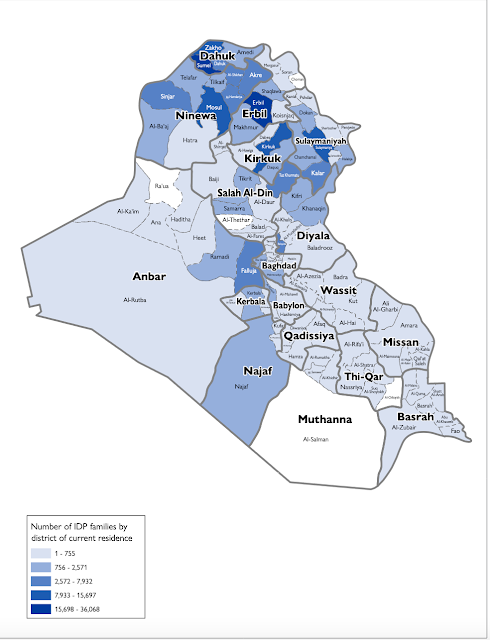 |
| (IOM) |
The International Organization for Migration (IOM) is the pre-eminent group working on displacement with the Iraqi government. It released its latest report for the first four months of 2023 and found barely any change in the number of internal refugees from the end of 2022.
The IOM recorded 1,157,115 displaced (IDPs) in Iraq in April. That was down just 11,504 people from the last report. That was an average of 2,876 returns per month. From October to December 2022 there was an average of 3,726 returns per month.
Every year the number of IDPs going home each month has decreased from 78,746 in 2018 to 35,927 in 2019 to 19,593 in 2020 to 10,125 in 2021.
Avg 78,746 returns per month 2018
Avg 35,927 returns per month 2019
Avg 19,593 returns per month 2020
Avg 10,125 returns per month 2021
Avg 3,726 returns per month Oct-Dec 2022
Avg 2,876 returns per month Jan-Apr 2023
This decline has happened despite the Sudani and Kazemi governments wishing to close the file on this problem by shutting down camps and forcing people out.
There are number of reasons why IDPs will remain an issue in Iraq. First, there are many families associated with the Islamic State which are not allowed to go back to their home areas by the local authorities, the security forces and tribes. Second, some war torn areas were never rebuilt like the Sinjar district in Ninewa where the majority of residents have not gone back. That area lacks services, jobs, and much of the housing remains destroyed. Baghdad never allocated a serious amount of funds to reconstruction after the war with the Islamic State. Last, armed groups have forcibly displaced people and not let them back. The entire Jurf al-Sakhr district in northern Babil was emptied of people by the Hashd and then turned into a large military base by Kataib Hezbollah. It has not allowed anyone back to secure its facilities as well as to protect the route Shiite pilgrims use to go to the holy cities of Najaf and Karbala. The Islamic State also threatened dozens of villages in central and northeast Diyala and southern Kirkuk to create safe havens. None of these conditions will change anytime soon and Iraq will likely remain with one million IDPs. This is exactly what happened after the 2005-08 civil war when one million people never went home. The Iraqi government is ultimately responsible for both situations because it has never seriously tried to end the problem. If an issue doesn’t serve elite interests it will never be a priority and that’s true of displacement in Iraq.
SOURCES
International Organization for Migration, “Displacement Index, Findings: Round Six, Data Collection Period: January-April 2023,” May 2023
-“Iraq Master List Report, Data Collection Period: January-April 2023,” June 2023




No comments:
Post a Comment